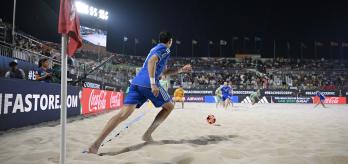Incredibly, just eight goals were conceded from corners during FIFA Beach Soccer World Cup UAE 2024™ from a total of 753 corners taken.
The three types of marking systems
Across the tournament, teams used man-marking, zonal and hybrid sytems (combining man-marking with zonal). When our Technical Study Group (TSG) analysed the defensive corner set-ups across the tournament, there was no particular structure that proved more effective than another. Instead, it was more often individual-player roles within a set-up that defined its success in defensive (or offensive) situations.
As can be seen in the graphic below, all but three teams (Colombia, Egypt and Tahiti) ranked below the tournament average (represented by dotted white line) for man-marking set-ups during corners, while the USA showed the strongest preference for this system. Colombia used the hybrid approach more than any other team (for 78% of their defensive corners), while zonal marking was used the least by all teams, with Japan using it for a higher percentage of their defensive corners set-ups (29%) than other teams.
Only Oman and the UAE conceded more than one goal from a corner, while Colombia, Egypt, Spain and Tahiti were the only other teams to concede a goal in the defensive corner phase (which is any passage of play taking place between the corner kick and the ball going out of play, the attacking team recycling the ball into a build-up phase, or the attacking team losing possession to the defending team).
Defending corners to transition to attack – Spain
One defensive corner tactic that piqued the interest of the TSG came from Spain. When defending corners, the Group B team deliberately deployed players higher up the pitch to facilitate an attacking transition should they regain possession after the set play.
As outlined by Matteo Marrucci, “We have not seen this type of approach in beach soccer very much before and it poses real questions for the attacking team. Do we attack with four or bring a player back? As a coach, I found this very interesting, and the instructions were clearly coming from Spain’s technical area, so it had been worked on in advance of the tournament.”
In clip 1 below, from Spain’s match against Tahiti, we can clearly see how David Ardil (5) is positioned halfway up the pitch on the corner-taking side, leaving Spain defend a 3v3 situation. As soon as the goalkeeper catches the ball, he immediately throws it to Ardil, who is completely unmarked, giving him the time and space to attempt a bicycle kick.
The screenshots below were taken during Spain’s group-stage match against Argentina. This time Spain leave two players high up the pitch. As Marrucci explains, “This was fascinating because we can see coach Christian Mendez instructing his players in relation to Argentina’s responses. Initially, when Chiky (11) stays up and moves to the side of the corner, Argentina bring one of their players back to protect against the counter-attack. But straight away, Mendez instructs Cabrera (7) (who is now a spare player because the player he was marking was called back) to push forward. This gives Spain a 2v1 advantage over the defender if there is a transition to attack. This was an interesting tactic.”
Summary
While there is no “best” defensive set-up when defending corners, teams at the FIFA Beach Soccer World Cup 2024 showed strong preferences for man-marking and hybrid approaches over zonal set-ups. With only eight goals in total conceded from corners during the tournament, teams are demonstrating an ability to neutralise attacking threat from this type of set play through their organisation and marking system of choice.
Spain’s tactic of keeping one – or sometimes two – players high when defending corners was an innovative approach as they looked to use their spare outfield player (when man-marking) in a more attacking way.



















